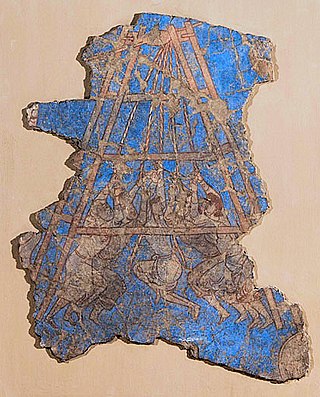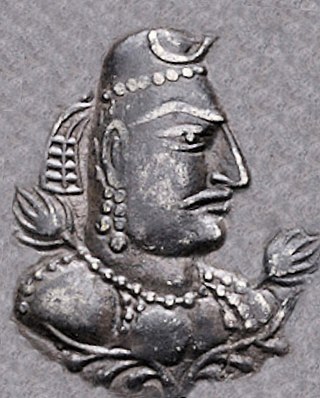
Khosrow I, traditionally known by his epithet of Anushirvan, was the Sasanian King of Kings of Iran from 531 to 579. He was the son and successor of Kavad I.

Kavad I was the Sasanian King of Kings of Iran from 488 to 531, with a two or three-year interruption. A son of Peroz I, he was crowned by the nobles to replace his deposed and unpopular uncle Balash.

Hormizd IV was the Sasanian King of Kings of Iran from 579 to 590. He was the son and successor of Khosrow I and his mother was a Khazar princess.

Peroz I was the Sasanian King of Kings of Iran from 459 to 484. A son of Yazdegerd II, he disputed the rule of his elder brother and incumbent king Hormizd III, eventually seizing the throne after a two-year struggle. His reign was marked by war and famine. Early in his reign, he successfully quelled a rebellion in Caucasian Albania in the west, and put an end to the Kidarites in the east, briefly expanding Sasanian rule into Tokharistan, where he issued gold coins with his likeness at Balkh. Simultaneously, Iran was suffering from a seven-year famine. He soon clashed with the former subjects of the Kidarites, the Hephthalites, who possibly had previously helped him to gain his throne. He was defeated and captured twice by the Hephthalites and lost his recently acquired possessions.
The Hephthalites, sometimes called the White Huns, were a people who lived in Central Asia during the 5th to 8th centuries CE, part of the larger group of the Iranian Huns. They formed an empire, the Imperial Hephthalites, and were militarily important from 450 CE, when they defeated the Kidarites, to 560 CE, when combined forces from the First Turkic Khaganate and the Sasanian Empire defeated them. After 560 CE, they established "principalities" in the area of Tokharistan, under the suzerainty of the Western Turks and of the Sasanian Empire, before the Tokhara Yabghus took over in 625.
The Kidarites, or Kidara Huns, were a dynasty that ruled Bactria and adjoining parts of Central Asia and South Asia in the 4th and 5th centuries. The Kidarites belonged to a complex of peoples known collectively in India as the Huna, and in Europe as the Chionites, and may even be considered as identical to the Chionites. The 5th century Byzantine historian Priscus called them Kidarite Huns, or "Huns who are Kidarites". The Huna/Xionite tribes are often linked, albeit controversially, to the Huns who invaded Eastern Europe during a similar period. They are entirely different from the Hephthalites, who replaced them about a century later.

Bahrām Chōbīn or Wahrām Chōbēn, also known by his epithet Mehrbandak, was a nobleman, general, and political leader of the late Sasanian Empire and briefly its ruler as Bahram VI.

The First Perso-Turkic War was fought during 588–589 between the Sasanian Empire and Hephthalite principalities and its lord the Göktürks. The conflict started with the invasion of the Sasanian Empire by the Turks and ended with a decisive Sasanian victory and the reconquest of lost lands.

Chaghaniyan, known as al-Saghaniyan in Arabic sources, was a medieval region and principality located on the right bank of the Oxus River, to the south of Samarkand.

Bagha Qaghan was the seventh Khagan (587–588) of the Eastern Wing of Göktürks during the turmoil inside the khaganate. He is given as Chǔluóhóu (处罗侯) in Chinese records, and as Šāwa, Sāva, or Sāba in Sasanian-based sources.

The Muslim conquest of Transoxiana or Arab conquest of Transoxiana were the 7th and 8th century conquests, by Umayyad and Abbasid Arabs, of Transoxiana, the land between the Oxus and Jaxartes rivers, a part of Central Asia that today includes all or parts of Uzbekistan, Tajikistan, Kazakhstan, and Kyrgyzstan.

The Battle of Gol-Zarriun, also known as Battle of Bukhara, took place in c. 560 when the Sasanian Empire allied with the First Turkic Khaganate against the Hephthalite Empire.

The Principality of Chaghaniyan, known in Arabic sources as al-Saghaniyan, was a part of the Hephthalite Confederation from the 5th to the 7th century CE. After this, it was ruled by a local, presumably Iranian dynasty, which governed the Chaghaniyan region from the late 7th-century to the early 8th-century CE. These rulers were known by their titles of “Chaghan Khudah”.

The Principality of Ushrusana was a local dynasty ruling the Ushrusana region, in the northern area of modern Tajikistan, from an unknown date to 892 CE. Ushrusana, just like Ferghana, did not belong to Sogdia proper, but its inhabitants wrote in Sogdian, and may have spoken the Sogdian language as well. The rulers of the principality were known by their title of Afshin.

The Alchon Huns, also known as the Alkhan, Alchono, Alxon, Alkhon, Alakhana, and Walxon, were a nomadic people who established states in Central Asia and South Asia during the 4th and 6th centuries CE. They were first mentioned as being located in Paropamisus, and later expanded south-east, into the Punjab and Central India, as far as Eran and Kausambi. The Alchon invasion of the Indian subcontinent eradicated the Kidarite Huns who had preceded them by about a century, and contributed to the fall of the Gupta Empire, in a sense bringing an end to Classical India.

The term Iranian Huns is sometimes used for a group of different tribes that lived in Central Asia, in the historical regions of Transoxiana, Bactria, Tokharistan, Kabul Valley, and Gandhara, overlapping with the modern-day Afghanistan, Tajikistan, Uzebekistan, Eastern Iran, Pakistan, and Northwest India, between the fourth and seventh centuries. They also threatened the Northeast borders of Sasanian Iran and forced the Shahs to lead many ill-documented campaigns against them.
Kadagistan was the name of an eastern Sasanian province in the region of Tokharistan, established by Khosrow I after his victory over the Hephthalite Empire in 557. The capital of the province was Warlu, a city located in the valley of the Kunduz River.

The Tokhara Yabghus or Yabghus of Tokharistan were a dynasty of Western Turk–Hephtalite sub-kings with the title "Yabghus", who ruled from 625 CE in the area of Tokharistan north and south of the Oxus River, with some smaller remnants surviving in the area of Badakhshan until 758 CE. Their legacy extended to the southeast where it came into contact with the Turk Shahis and the Zunbils until the 9th century CE.
The siege of Tbilisi (627-628) was a siege by the Byzantine Empire and Western Turkic Khaganate in 627-628 against Prince Stephen I of Iberia, the Sasanid vassal ruler of Sasanian Iberia.
The Sasanian–Kushan Wars were a series of wars between the newly established Persian Sasanian empire, under Ardashir I and later his successor Shapur I, against the declining Kushan empire. These wars resulted in the eastward expansion of the Sasanians who conquered much of the Kushan territory including Bactria, Gandhara and Sogdia. The Sassanids, shortly after victory over the declining Parthian empire, extended their dominion to most of former Parthian lands, including Bactria, during the reign of Ardashir I around 230 CE, then they further expanded to the eastern parts of their empire in what is now western Pakistan, at the expense of warring against the declining Kushan empire, during the reign of his son Shapur I (240–270). Thus the Kushans lost their western territory to the rule of Sassanid nobles, who eventually established their own states and were collectively referred to as Kushanshahs or "Kings of the Kushans". At their greatest extent, these Kushano-Sasanians also seem to have expanded eastwards all the way to Gandhara, however do not seem to have crossed the Indus river, since almost none of their coinage has been found in the city of Taxila, just beyond the Indus.















